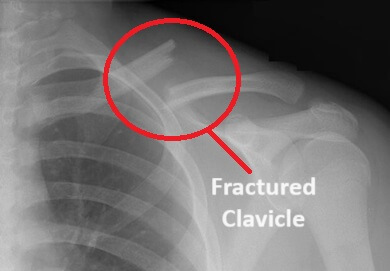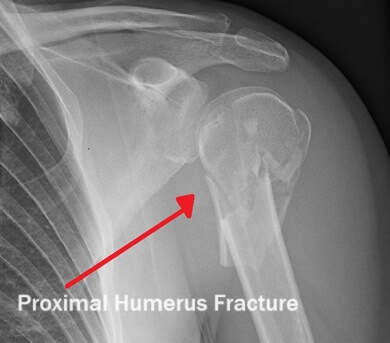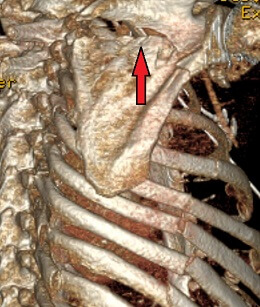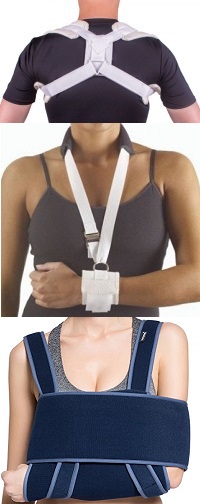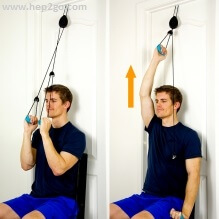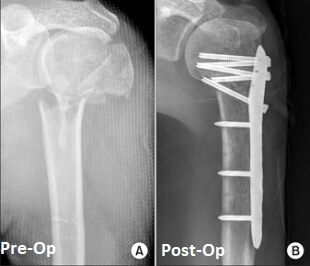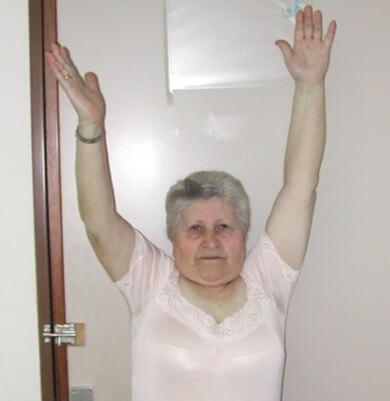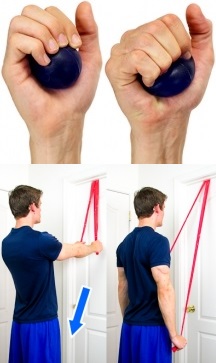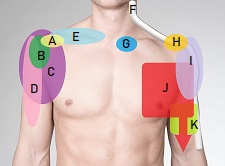- Home
- Shoulder Pain Causes
- Shoulder Fractures
Shoulder Fracture
Written By: Chloe Wilson BSc (Hons) Physiotherapy
Reviewed By: SPE Medical Review Board
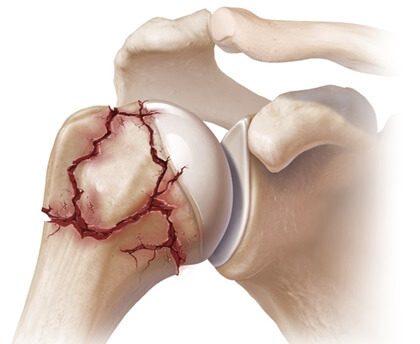
A shoulder fracture is where one of the shoulder bones breaks into two or more pieces.
The most common causes of shoulder fractures are a fall or a direct blow to the shoulder. Shoulder fractures can be really painful and make it difficult to use the arm.
In most cases, a broken shoulder does not require surgery. The arm will be supported in a sling initially to allow it to heal and then a rehab programme is followed under the guidance of a physical therapist.
Types Of Shoulder Fracture
Shoulder fractures may occur at the:
- Clavicle: aka collar bone. Broken collar bones are the most common shoulder fracture in children
- Humerus: aka upper arm bone. Proximal humerus fractures at the very top of the upper arm are the most common shoulder fractures in adults
- Scapula: aka shoulder blade. Scapula fractures are rare.
Each type of shoulder fracture may be classified by the position of the bones:
- Non-Displaced Fracture: where the broken bone remains in its usual position
- Displaced Fracture: where the bone has moved out of position by more than 1cm
- Comminuted Fracture: where the bone has broken in to three or more pieces
Here we will look at the different types of shoulder fracture, what causes them, how they present and how to treat them.
1. Clavicle Fractures
The clavicle, or collar bone, is a thin, long bone found at the front of the shoulder just in front of the top of the rib cage. It links the sternum (breastbone) to the scapula (shoulder blade).
Clavicle fractures are not only the most common type of shoulder fracture in children, the collar bone is actually the most common bone in the whole body that kids break. Luckily, they usual heal really well without the need for surgery, although they can be very painful for a couple of weeks.
What Causes Clavicle Fractures?
Collar bone fractures are commonly caused by:
- A Fall: either onto the side of the shoulder or when the arm is outstretched. You don’t have to fall very far to break your collarbone, it just depends on the angle of your arm and which bit you land on. I managed to break my collar bone age 5 falling out of the bottom bunk bed!
- Direct Contact: A sudden, strong blow to the collar bone can break it such as a rugby tackle
- Child Birth: Occasionally, babies experience shoulder fractures, particularly of the collarbone, during childbirth. This is most common when the baby is breech, where the babies bottom comes out first instead of their head
There are three types of clavicle fracture, depending on which part of the bone is broken. The most common is a type 1 fracture, where the break is located in the middle third of the bone, as this is the weakest part of the bone.
You can find out loads more information about the causes, symptoms, treatment and recovery in the clavicle fractures section.
2. Humerus Fractures
Humerus fractures are the most common type of shoulder fracture in adults.
The humerus is the long bone in the upper arm that sits between the elbow and the shoulder.
The top of the humerus forms a ball shape known as the humeral head that rests in a socket formed by the shoulder blade.
Humerus fractures fall into three categories:
- Proximal Humerus Fractures: The most common place to break the humerus is right at the top at the humeral head. Proximal humerus fractures account for approximately 5% of all fractures and are the most common type of shoulder fracture in the over 65’s
- Humeral Shaft Fracture: A break anywhere in the middle section of the long bone. There may be associated damage to the surrounding nerves or blood vessels. Humeral shaft fractures account for 3% of all fractures
- Distal Humerus Fracture: A break towards the bottom of the bone, near the elbow
Causes of Humeral Fractures
Shoulder fractures of the humerus bone are most typically caused by falling over. Your body’s natural reaction when you fall is to put your arms out to catch yourself, but falling onto an outstretched arm often leads to humeral fractures. A direct blow to the humerus or torsion (rotating force) through it can also, if strong enough, cause the bone to break.
Humeral fractures typically affect people over the age of 65 and are twice as common in women as men. Bone density decreases with age and bones become more brittle meaning less force is require to break them, particularly if there are osteoporotic changes. In younger people, high energy trauma is required for the humerus to break, such as falling from a tree, and as a result the injury is likely to be more serious.
You can find out more about the causes, symptoms and treatment options in the proximal humerus fracture and humeral shaft fracture sections.
3. Shoulder Blade Fractures
A broken shoulder blade, aka scapula fracture, is the least common type of shoulder fracture. The bone is strong and well protected so it takes a great deal of force to break it.
The shoulder blade is rarely damaged in isolation and scapula fractures are typically accompanied by injuries to the chest region which may be severe such as broken ribs and lung damage. Scapula fractures are rare and account for less than 1% of all fractures.
Any part of the shoulder blade may break, but most commonly it is the body of the scapula that is injured rather than the neck or spine.
Causes of Scapular Fractures
Shoulder blade fractures are usually caused by RTA’s, either in a car, on a motorbike or high speed bike collisions. Then can also be caused by a fall from a great height, a hard blow to the back of the shoulder region such as in sporting injuries, or a crush injury.
The shoulder blade can also break during a seizure or from an electric shock as these can cause the muscles that control the shoulder blade to contract powerfully in different directions, pulling on the bone.
Shoulder blade fractures are most common between the ages of 25 and 40.
Symptoms of Shoulder Fractures
If you have a shoulder fracture, you generally know about it instantly and will be able to recall a specific incident. Whichever bone you have broken around the shoulder, there is usually a sharp pain at the time of injury which gives way to an ongoing dull ache.
The pain from shoulder fractures tends to get worse with any arm movement, especially when trying to lift your arm above your head, when any pressure is placed on the affected area or when taking a deep breath. Arm movement will almost certainly be restricted. There is usually extensive bruising.
Specific symptoms for the different types of shoulder fracture include:
- Clavicle Fracture Symptoms: A bulge over the broken area and a snapping or grinding noise when you move your arm
- Humerus Fracture Symptoms: Severe swelling and bruising in the upper arm and there may be an obvious deformity
- Scapula Fracture Symptoms: Bruising over the shoulder blade region. In approximately 80% of cases of scapula fractures there are associated injuries to the shoulder, spine, head, rib cage and/or lungs which may be very serious.
#CommissionsEarned from Amazon on qualifying purchases
Treatment For Shoulder Fractures
In most cases, as long as the fracture is stable and minimally displaced, shoulder fractures do not require surgery. Non-operative treatment for a shoulder fracture involves:
1. Sling
With a shoulder fracture, the arm will be immobilized in a sling for at least the first 10-14 days and often 3-4 weeks, sometimes more, to allow the fracture to heal. The type of sling will depend on which bone has been broken:
- Clavicle Fracture Sling: A figure of 8 sling is a popular choice with clavicle fractures as it immobilizes the collar bone while supporting the shoulders and upper back to ensure good posture
- Humeral Fracture Sling: Proximal humerus fractures are treated initially with an immobilizer sling to support the fracture as it heals. Humeral shaft fractures are usually treated with a brace and a collar and cuff style sling rather than a triangular sling. This is because by leaving the elbow unsupported, gravity and the weight of the arm draws the humerus downwards helping the bone to heal in the correct position. If there is pressure up through the elbow, it can displace the bone causing it to heal in the wrong position
- Scapula Fracture: A sling and shoulder immobiliser is typically used with shoulder blade fractures to keep the arm supported and close to the body.
2. Medication
Your doctor will prescribe pain relieving medication following a shoulder fracture such as paracetamol/Tylenol or NSAID's e.g. ibuprofen/Advil. Shoulder fractures are often very painful the first few weeks so it is important to take your painkillers regularly to stay on top of the pain.
3. Shoulder Exercises
In the first few days after a shoulder fracture, it is very important not to move the shoulder as the bone needs time to heal. If you keep moving it, your shoulder fracture may either heal in the wrong position or not heal at all.
But at the same time it is important to keep the fingers, wrist and elbow moving regularly by doing simple exercise or else they will get very stiff. In most cases it is fine to take your arm out of the sling to do these. It can help to get a grip strengthening tool to keep your hand and lower arm nice a strong.
As soon as the doctor is happy that the shoulder fracture is healing well (they will perform regular x-rays to check how things are progressing), your physiotherapist will start you on a range of mobility exercises to restore the range of movement in the shoulder.
This usually happens after 2-3 weeks and typically start with pendulum exercises and then active assisted exercises where you use your good arm to support and move the broken arm. You may also be advised to use a shoulder pulley system - they are a great tool for increasing shoulder range of motion.
In terms of strengthening, hand and forearm strengthening exercises are started immediately and after a few weeks you can start gentle shoulder strengthening exercises. You will often start with isometric exercises where you strengthen the arm without moving the shoulder.
At around 6-8 weeks, if everything is healing properly, you will progress on to more advanced strengthening exercises. You can find a whole range of exercises that will help in the early stages in the shoulder mobility exercises section.
4. Shoulder Surgery
Only around 10-20% of shoulder fractures will require surgery. Shoulder fracture surgery is indicated if:
- The bone fragments are displaced
- The bone has punctured the skin, known as an open fracture
- There is damage to the surrounding nerves or blood vessels
- There is damage to the parts of the bone where the rotator cuff muscles attach
- If the damage affects the surfaces of the shoulder joint
- If there is a fracture dislocation – where the shoulder joint has dislocated as well as been broken
- If more than one of the shoulder bones is fractured
- If the fracture fails to heal, known as non-union
Surgery for a shoulder fracture involves realigning the bones and then fixing them in place with either plates, screws or rods.
If there is significant damage to the humeral head which can’t be fixed, then the top part of the humerus is replaced, known as a hemi-arthroplasty or partial shoulder replacement.
Following surgery, treatment is very similar to the non-surgical treatment with a period of immobilization in a sling and then progressing through a rehab program under the guidance of a physical therapist.
You can find out more about the different surgical options and the recovery process for clavicle fractures, proximal humerus fractures and midshaft humerus fractures in the relevant sections.
Recovering From A Shoulder Fracture
Full recovery from a shoulder fracture, whether it is treated surgically or not, can take 6-12 months. It is very important to get the right balance between allowing the fracture time to heal while also trying to prevent stiffness.
Younger patients should regain full range of movement and function in their arm after a broken shoulder. Elderly patients however do not always regain full movement but in most cases they will regain enough function to do their day to day activities.
Many people are scared to move their arm after a shoulder fracture but you make the best recovery when you follow the advice of your physical therapist. If they have given you the all clear to get the shoulder moving, diligently stick to your rehab programme.
Moving a stiff joint is often painful, but the only way to get the movement back is to be doing your exercises, aiming to regain more movement each week.
It may help to apply a heat pack prior to exercise to help loosen up the shoulder, and to time when you do your exercises around your painkillers. Your physical therapist will be able to advise you on how much to push things.
Here are some top tips for people recovering from shoulder fractures:
- Washing: Usually it is fine to take your arm out of the sling to wash after a shoulder fracture – check this with your doctor. Take extra care as you may find your balance is affected. The best way to wash your armpit is to bend forwards so your arm swings forwards as with pendulum exercises
- Wound Care: If you have had shoulder surgery it is important to keep the wound clean and dry for the first 7-10 days
- Dressing: You should be able to get dressed independently within a few days of your shoulder fracture but you may want to think about what you wear. People often find it easier to wear tops that fasten at the front rather than ones that go over your head.
When putting on tops, put your affected arm in its sleeve first and then carry on with your good arm. With a bra it is often easier to fasten/unfasten it around the front of your chest and then twist it round so you don’t have to reach behind your back - Smoking: Studies have shown that smoking delays fracture healing so it is important not to smoke until your shoulder fracture has fully healed
- Exercises & Physical Therapy: Diligently follow the advice of your physical therapist. Hand, wrist and elbow exercises are usually started immediately. Grip strengtheners and hand therapy balls are a great way to maintain the strength in your forearm and hand without aggravating your shoulder in the early stages.
When you start shoulder mobility exercises, it is important to do them at least 2-3 times a day to reduce shoulder stiffness and regain mobility - pulleys can really help. In terms of regaining strength in the shoulder and arm muscles, resistance bands are a great way to build up strength - visit the shoulder rehab section for a whole range of suitable strengthening exercises.
And remember, you will continue to make progress for up to a year after a shoulder fracture, so don’t give up too soon. Persevere with your rehab exercises until you have regained full of movement and then make sure you keep it - Driving: You will not be able to drive for a number of weeks after a shoulder fracture. You need to regain enough movement and strength in the arm to be able to drive safely, which usually takes at least 8 weeks.
Your doctor or physical therapist will advise when you are safe to start driving again and it is a good idea to inform your insurance company what has happened - Returning To Work: Returning to work after a shoulder fracture will depend on the nature of your job and whether it is your dominant arm that you have broken. You may be able to return to work after a couple of weeks if you can get by only using one arm. However if your job requires any manual labour you are likely to be off work for at least 3 months
- Sports: It may be possible to return to non-contact sports after around 6 weeks, but contact sports should be avoided for 3-6 months until the fracture has fully healed. Follow the advice of your physical therapist.
What Else Can Help?
Exercises are such an important part of the rehab process when recovering from any type of shoulder fracture. Visit the shoulder mobility exercises and the shoulder rehab section for a whole range of exercises that will help
If you want to know more about the different types of shoulder fracture, visit the:
- Clavicle Fractures section to find out about a broken collar bone
- Proximal Humerus Fracture section to find out about fractures at the shoulder joint
- Midshaft Humerus Fractures section to find out about fractures of the upper arm
There are lots of other causes of upper arm pain so if a shoulder fracture isn't sounding like your problem, check out the shoulder pain diagnosis section.
Related Articles
Page Last Updated: May 21st, 2024
Next Review Due: May 21st, 2026
